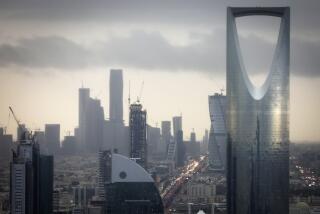Dubai’s Burj Khalifa is a tower to look up to
- Share via
The Burj Dubai, or as it was renamed during its opening Monday, the Burj Khalifa, has been likened to the Tower of Babel, or in the words of Times architecture critic Christopher Hawthorne, “a tombstone for some ruined ideas.” That’s because the structure that has shattered the record for world’s tallest building had the misfortune to be completed in the midst of a global recession, after Dubai’s real estate market had all but collapsed.
The tower may well be, as the headline on Hawthorne’s critique called it, a “temple to hubris.” It may also be the latest entry in a contest Sigmund Freud would have found worthy of a treatise -- the compulsion to boast the world’s biggest urban erection. Yet if its corkscrew shape and outsized ambitions have raised comparisons to Babel, it reminds us more of another skyscraper that appeared under disastrous economic conditions but whose value was always more symbolic than economical: the Empire State Building.
When it opened in 1931 in the midst of the Depression, the erstwhile world titleholder for height was derided as the “Empty State Building” because hardly any tenants could be found to occupy it. No matter; the Art Deco masterpiece was a spectacular accomplishment for its time, a statement about the optimism of its builders, the might of its city and the pride of its nation. No tower could touch it for 40 years, until New York and Chicago started a spire-measuring contest by raising the World Trade Center and Sears Tower (now Willis Tower).
American cities have stopped playing this game because few investors want to take on the enormous risks involved; moreover, the United States is probably feeling potent enough that it no longer needs to overcompensate with such grand symbolic gestures. Yet the world’s emerging economic powerhouses still have tower envy. Hence seven of the 10 tallest buildings in the world can now be found in Asia, and the newest address in the brash city-state of Dubai tops out at 2,717 feet -- about as tall as both towers of the World Trade Center stacked on top of each other.
The state-owned developer that built the Burj Khalifa may never make back its whopping $1.5-billion investment, but Dubai has certainly made a statement. And you can call it hubris, but we’re in awe of the architectural and engineering achievement it represents.
More to Read
Sign up for Essential California
The most important California stories and recommendations in your inbox every morning.
You may occasionally receive promotional content from the Los Angeles Times.










